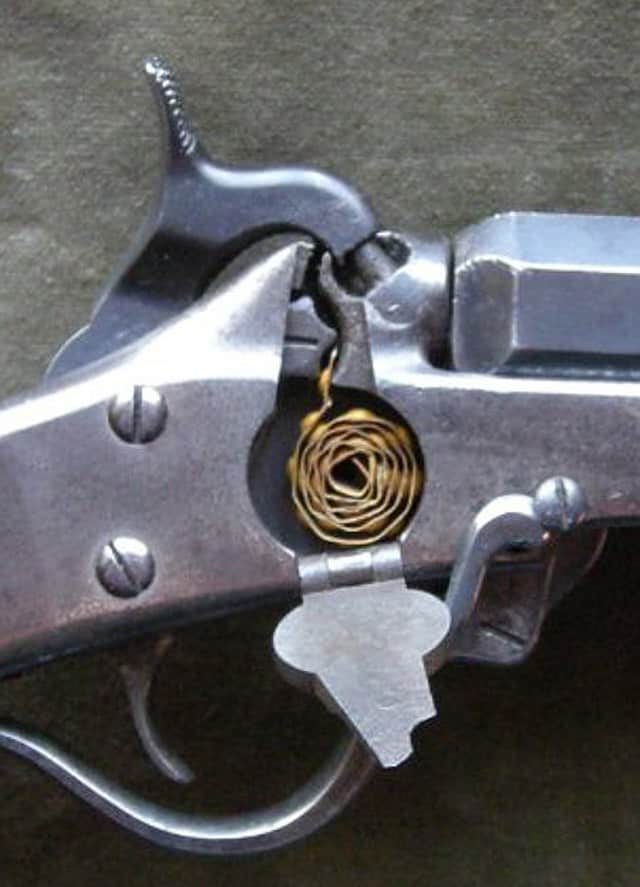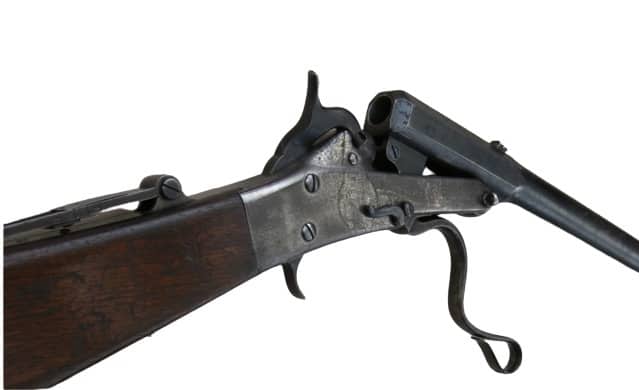
The Maynard Carbine: A Pioneering American Breechloader
The Maynard Carbine stands as a significant milestone in the evolution of American firearms, renowned for its innovative design, exceptional accuracy, and widespread use during the American Civil War. Developed by Dr. Edward Maynard, a dentist with an extraordinary talent for firearm engineering, the Maynard introduced advanced breech-loading technology that influenced future metallic cartridge development.
Origins and Development

Dr. Edward Maynard, an accomplished firearms inventor, patented his Maynard Tape Primer System in 1845, which revolutionized ignition systems by introducing a roll-fed priming mechanism. This design was initially applied to Springfield Model 1855 Rifles before becoming the defining feature of his own Maynard Carbine, patented in 1851 and refined over the following years.
The carbine was manufactured by the Massachusetts Arms Company, headquartered in Chicopee Falls, Massachusetts, with production commencing in 1857. Early adopters praised the Maynard for its rapid reloading capability and accuracy, leading to its procurement by both military forces and civilians.
Two Primary Models
Two distinct versions of the Maynard Carbine were produced:
- First Model (1857–1860): Equipped with Maynard's patented tape primer system, which automatically fed a priming cap with each cock of the hammer. Available in .35 caliber and .50 caliber, approximately 3,500–5,000 units were manufactured before production ceased due to vulnerability to moisture and field failures.
- Second Model (1863–1865): Transitioned to a traditional percussion cap ignition system, improving reliability in battlefield conditions. Manufactured exclusively in .50 caliber, with approximately 16,702 units produced during the war.
Combat and Civil War Usage
The Maynard Carbine was widely used by both Union and Confederate cavalry units. The Union Army initially tested Maynard rifles before the war, but widespread adoption occurred later with the Second Model’s introduction. Southern forces also favored the Maynard, especially early in the war when thousands were acquired through pre-war purchases and battlefield captures.
One of the most notable proponents of the Maynard was Confederate General J.E.B. Stuart, who valued its accuracy and dependability. Contemporary accounts suggest Stuart carried a Maynard until his fatal wounding at the Battle of Yellow Tavern in 1864.
Maynard Carbines were also issued to Confederate cavalry regiments, including those in Mississippi, Georgia, Florida, and South Carolina. Reports from Confederate horsemen highlight the weapon’s efficiency, noting that it provided a faster rate of fire than muzzleloaders and remained reliable even under harsh field conditions. However, a persistent problem was the scarcity of proprietary Maynard cartridges, which limited its long-term battlefield use in the South.
The Maynard was one of several carbines competing for dominance during the war, including the Spencer Repeating Carbine, Smith Carbine, Burnside Carbine, Gallager Carbine, Morse Carbine, Starr Carbine, and the Henry Rifle. Among these, the Maynard was respected for its accuracy but lacked the firepower of repeaters like the Spencer or Henry.
Technical Specifications and Ballistics

The Maynard Carbine’s technical design was ahead of its time, featuring a simple yet effective breech-loading mechanism that improved reload times over traditional muzzleloaders.
Specifications
- First Model:
- Caliber: .35 and .50
- Barrel Length: 20 inches
- Overall Length: 36.5 inches
- Weight: ~6.5 lbs
- Ignition System: Maynard Tape Primer
- Second Model:
- Caliber: .50 only
- Barrel Length: 20 inches
- Overall Length: 36.5 inches
- Weight: ~6.5 lbs
- Ignition System: Percussion cap
Ballistics
- .50 caliber Maynard Cartridge
- Bullet Weight: ~350 grains
- Muzzle Velocity: ~950 feet per second (fps)
- Effective Range: ~200–300 yards
This combination of breech-loading efficiency and substantial ballistic energy made the Maynard a powerful cavalry weapon, offering superior reload speed compared to muzzle-loading muskets.
Post-War Evolution and Civilian Use
Following the Civil War, the Massachusetts Arms Company continued refining the Maynard, producing sporting rifles under the Maynard 1873 and 1882 models. These rifles catered to hunters, target shooters, and buffalo hunters, with calibers such as .40 and .45 becoming particularly popular.
The Maynard’s brass-cased ammunition remained highly regarded for accuracy and ease of reloading, making it a preferred choice for competitive sharpshooters in the late 19th century. The Maynard system’s influence can be seen in later self-contained metallic cartridges, paving the way for widespread adoption of modern ammunition.
Legacy and Influence on Modern Firearms

While the Maynard Carbine itself did not directly evolve into a modern successor, its design principles influenced later breechloaders and early cartridge firearms. The concept of a removable brass cartridge, though externally primed in Maynard’s design, was a precursor to self-contained metallic cartridges that would dominate firearms technology by the 1870s.
Additionally, the Maynard Tape Primer, despite being abandoned due to its susceptibility to moisture, was a key step in automating ignition systems, later seen in integrated primer cartridges.
Collectors today prize Maynard rifles for their historical significance, mechanical ingenuity, and remarkable accuracy. Surviving examples, particularly early First Model variants with intact tape primer mechanisms, are highly sought after in the antique firearms market.
Conclusion
The Maynard Carbine was a technological trailblazer that demonstrated the potential of breech-loading firearms in both military and civilian applications. Its accurate, fast-firing, and lightweight design made it a preferred weapon for cavalry troops, particularly in the Confederate ranks, while its influence extended well beyond the Civil War into the era of modern metallic cartridges.
From its pioneering tape primer system to its brass-cased ammunition, the Maynard left an indelible mark on firearm development. Whether in the hands of Civil War cavalrymen, post-war hunters, or precision marksmen, the Maynard Carbine remains a testament to 19th-century firearms innovation and an enduring piece of American history.
Read more on this topic here:
Join the conversation about the Civil War and Civil War Weapons here.
If you know of any forums or sites that should be referenced on this listing, please let us know here.











